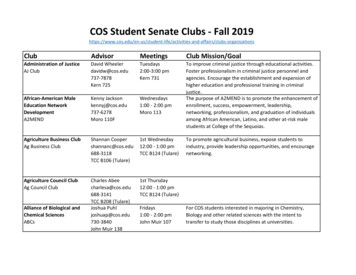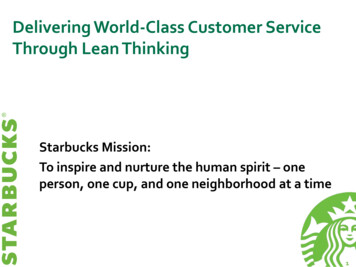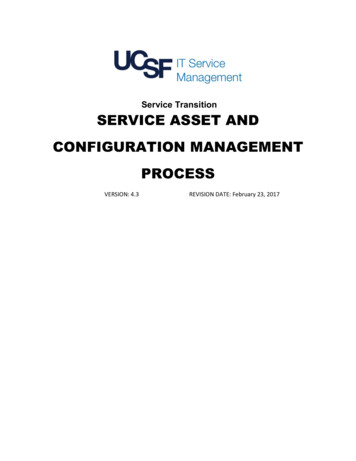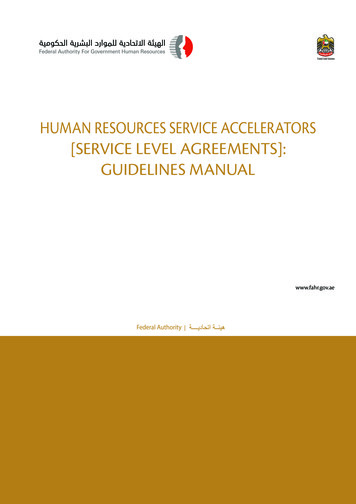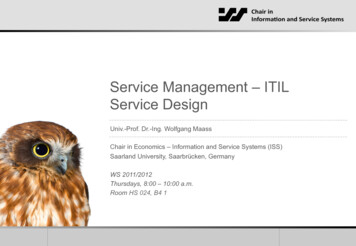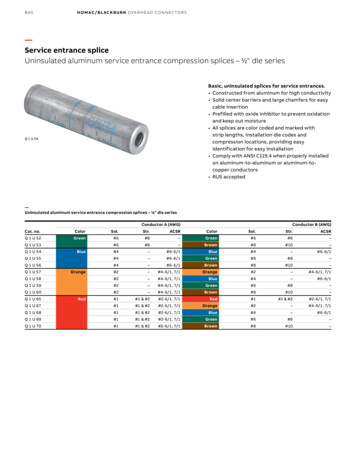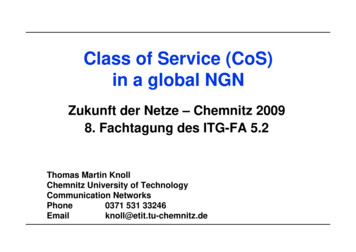
Transcription
Class of Service (CoS)in a global NGNZukunft der Netze – Chemnitz 20098. Fachtagung des ITG-FA 5.2Thomas Martin KnollChemnitz University of TechnologyCommunication NetworksPhone0371 531 33246Emailknoll@etit.tu-chemnitz.deZukunft der Netze, 20.3.2009 - 8. Fachtagung des ITG-FA 5.2 - TU Chemnitz - Th. M. Knoll
Outline1. Motivation2. State of the Art3. Proposed Improvements / Focus4. Addressed Issues5. Definition of new BGP Attributes6. Implementation / Practical usage7. Summary2 / 20Zukunft der Netze, 20.3.2009 - 8. Fachtagung des ITG-FA 5.2 - TU Chemnitz - Th. M. Knoll
MotivationStateFocusAd. IssuesAttributesPractical UseSummaryMotivation“Quality of Service (QoS) – what for ?” A generalized packet data network carries a mixture of throughput, delay andloss critical packetized information, organized in datagrams and flows.Approach: “Give each carried service the resources that are just right toachieve satisfactory service quality.”WikiISP BGoogleYoutubeISP AAmazonAkamaiZukunft der Netze, 20.3.2009 - 8. Fachtagung des ITG-FA 5.2 - TU Chemnitz - Th. M. Knoll3 / 20
MotivationStateFocusAd. IssuesAttributesPractical UseSummaryState of the ArtQuality of Service (QoS) – available within domains Differentiated Services (DiffServ) – widely accepted and consistently enabledwithin administrative domains (corporate networks, ISPs, etc.)Traffic separation in e.g. VLANs and MPLS tunnelsResource reservation for tunnels – common in larger networkssingle flow reservations only on sparse (radio) linksWiki GoogleMarking with trust relationshipsClassification queueing schedulingPartially with reservation admissioncontrolISP BYoutubeISP AAmazonAkamaiZukunft der Netze, 20.3.2009 - 8. Fachtagung des ITG-FA 5.2 - TU Chemnitz - Th. M. Knoll4 / 20
MotivationStateFocusAd. IssuesAttributesPractical UseSummaryState of the Art“Quality of Service (QoS) – what for ?” – the inter-domain case Massive over-provisioning to avoid any QoS problems (& discussions)Big enough to boldly request uncongested transfer linksUncoordinated (separate and competitive) network operationTrade-off: Transfer cost - QoS capable devices, setups, accounting,staff training, debugging, error predictabilityWiki“Throw bandwidth at the problem”“I don’t think about QoS, I’ve got v6”ISP BGoogleYoutubeISP AAmazonAkamaiZukunft der Netze, 20.3.2009 - 8. Fachtagung des ITG-FA 5.2 - TU Chemnitz - Th. M. Knoll5 / 20
MotivationStateFocusAd. IssuesAttributesPractical UseSummaryState of the Art“Quality of Service (QoS) – what for ?” – the inter-domain case Autonomous System - single administrative routing domainAS interconnection - peering (free) / transit (paid)Exchange of reachability information (routes attributes) through BGPQoS within AS commonly used (IPv4/IPv6 (layer 3) combined with lower layerQoS technologies (Ethernet 802.1D, MPLS Traffic Class – RFC5462)NOT available (commonly used): Inter-AS QoS Virtual Channels in lowerlayers for QoS Æmulti-parameter ingress classification / degraded qualityComplex approaches exist, which aim for guaranteed (parameterized) QoSsupport for inter-AS peeringsASBR T 1AS 2ASBR T1AS 14classesL2/L3BE peeringBE only transitL3 only transitBE peering3classesL2/L3Transit Provider NetworkAS1BAS 3AS3B6 / 20Zukunft der Netze, 20.3.2009 - 8. Fachtagung des ITG-FA 5.2 - TU Chemnitz - Th. M. Knoll
MotivationStateFocusAd. IssuesAttributesPractical UseSummaryKesim epProposed Improvements / Focuspl ite!Proposed Improvements Æ Inter-AS CoS Provides knowledge about the available traffic separations and markings.Cross-layer mapping & transitive Cross-domain signalling is a novelfeature. Enables marking adoption (and possibly route selection) without guarantees. Fair signalling of class overload limitations and excess traffic handling withlocal scope Greatly improves inter-AS packet forwarding. Twofold “free to join” concept (single or combined usage):1. global class set cross-layer marking signalling (transitive attribute)2. local class set rate limitation signalling (non-transitive attributes)Traffic Separation is key:QoS in this approach refers to primitive traffic separation into severalclasses, which will experience differently prioritized forwarding behaviour inrelaying nodes. Enqueueing in separate queues is thereby aspired.7 / 20Zukunft der Netze, 20.3.2009 - 8. Fachtagung des ITG-FA 5.2 - TU Chemnitz - Th. M. Knoll
MotivationStateFocusAd. IssuesAttributesPractical UseSummaryProposed Improvements / FocusFocus of the new ConceptDistinction between AS level CoS:1. CoS based Forwarding Æ use case2. CoS based Routing Æ possibly future use case3. CoS based Tunnelling Æ use case8 / 20Zukunft der Netze, 20.3.2009 - 8. Fachtagung des ITG-FA 5.2 - TU Chemnitz - Th. M. Knoll
MotivationStateFocusAd. IssuesAttributesSummaryDS-FieldAddressed Issues0 1 2 3 4 5 6 7Cross-Layer QoS mapping Practical UseECNDSCPcross-domain tunnelling of customer trafficÆconsistent inter-layer QoS couplingÆtransparent transport”E-LSPs”LabelClass SelectorCodepoints4 ByteExp.TTLSDifferentiated ServicesCodepointRFC 2474MPLS Label Stack Format662DASATPI 8100TPIVLAN TCITag Protocol IdentifierVLAN Tag Control Information2VLAN TCI2T/L46 . 1500DATA4PADBytesFCS3 Bit User PriorityThe aim is consistent classification and a consistent class-based forwardingbehaviour on all layers of an end-to-end traffic path.9 / 20Zukunft der Netze, 20.3.2009 - 8. Fachtagung des ITG-FA 5.2 - TU Chemnitz - Th. M. Knoll
MotivationStateFocusAd. IssuesAttributesPractical UseSummaryAddressed Issues (cont.)Cross-Domain QoS signalling Diverse usage and internal QoS strategies are not visible outside an ASIndividual agreements (SLA) on class support between neighbouring ASesExternal BGP (eBGP) is used for Inter-Domain signalling carrying transitiveCoS signallingeBGP route UPDATESwith CoS attributesThe aim is consistent classification and a consistent class-based forwardingbehaviour on all layers of a transit traffic path.10 / 20Zukunft der Netze, 20.3.2009 - 8. Fachtagung des ITG-FA 5.2 - TU Chemnitz - Th. M. Knoll
MotivationStateFocusAd. IssuesAttributesPractical UseSummaryAddressed Issues (cont.)CoS – Class Overload prevention Traffic separation and enqueueing into separate – prioritised – queues temptsusers to overload the higher priority classes.Limitation and punishment concept using Token Bucket filter at ingressnodesIngress Filtersto drop ordown-markexcess traffic11 / 20Zukunft der Netze, 20.3.2009 - 8. Fachtagung des ITG-FA 5.2 - TU Chemnitz - Th. M. Knoll
2324 16 Bytes filled with „0xFF“(incl. 19 header)[octet]Routes Length Length Route 1[bit][octet]19 octetPath AttributesType (2)Withdrawn RoutesWithdrawn var. lengthPrefix Route 1 (variable length)octet alignedPrefix Route N (variable length)octet alignedwellknownA t t r i b ut e T y p e 1Attr. Flags[octet]At. Type CodeAttr. Length 1Attribute Value 1 (variable length)[octet]Attr. Value 1Attr. LengthA t t r . T yp e E x t . Co m m u n i t ycontinued8 octet1 1 P 0 0 0 0 0 Type Code 16- Origin- AS-Path- Next HopFlagsAttr. Length N[octet]Length Route 1[bit]QoS Set NumberPath Attributesvar. lengthQoS MarkingExtended CommunityAttributeAttribute Value N (variable length)Prefix Route 1 (variable length)octet alignedIP prefix length[bits]Length Route N[bit]Prefix Route N (variable length)- Aggregator- MED- Community- Ext. Comm.NLRINetwork LayerRouting Information3123241615optionalvar. lengthoctet aligned781 - ORIGIN2 - AS PATH3 - NEXT HOP4 - MULTI EXIT DISC5 - LOCAL PREF6 - ATOMIC AGGREGATE7 - AGGREGATOR8 - COMMUNITIES14 - MP REACH NLRI15 - MP UNREACH NLRI16 – Ext. COMMUNITIES- LocalPreference- AtomicAggregateTechnology0 0 0 0 0 0 0 0 00 0 R I A 0 0TypeQoS Marking / QoS Marking / QoS Marking /ProcessingClass Number O Class Number O Class Number ACountAttribute Type NAttr. FlagsAt. Type Code019 4096 octetTotal Path Attribute LengthType highSummaryMessage HeaderIP prefix length[bits]Length Route N[bit]Practical UseBGP update message1 - OPEN2 - UPDATE3 - NOTIFICATION4 - KEEPALIVE5 - ROUTE-REFRESHMarkerTotal LengthAttributes31Ad. Issues16Focus15State780MotivationZukunft der Netze, 20.3.2009 - 8. Fachtagung des ITG-FA 5.2 - TU Chemnitz - Th. M. Knoll12 / 20
MotivationStateFocusAd. IssuesAttributesPractical UseSummaryDefinition of new BGP AttributesCross-domain CoS Signalling & Cross-layer qos-attribute“QoS Marking Attribute” - BGP Extended Community Attribute [RFC4360]Signalling of ‘original & active’ traffic class markings for several layers across ASesusing transitive extended communities with IANA assigned type 0x04.0 1 2 3 4 5 6 7 -- -- -- -- -- -- -- -- 0 0 0 R I A 0 0 -- -- -- -- -- -- -- -- 01230 1 2 3 4 5 6 7 8 9 0 1 2 3 4 5 6 7 8 9 0 1 2 3 4 5 6 7 8 9 0 1 - - - - - - - - - - - - - - - - - - - - - - - - - - - - - - - - 0 0 0 0 0 1 0 0 Flags QoS Set Number Technology Type - - - - - - - - - - - - - - - - - - - - - - - - - - - - - - - - QoS Marking O ( h & l ) QoS Marking A 0 0 0 0 0 0 0 0 - - - - - - - - - - - - - - - - - - - - - - - - - - - - - - - - 13 / 20Zukunft der Netze, 20.3.2009 - 8. Fachtagung des ITG-FA 5.2 - TU Chemnitz - Th. M. Knoll
MotivationStateFocusAd. IssuesAttributesPractical UseSummaryDefinition of new BGP AttributesCoS – Class Overload dr-cos-interconnect“CoS Capability Attribute” - BGP Extended Community Attribute [RFC4360]Signalling of supported traffic classes Æ currently limited to LE, BE, AF, EFusing non-transitive extended communities with IANA assigned type 0x40.14 / 20Zukunft der Netze, 20.3.2009 - 8. Fachtagung des ITG-FA 5.2 - TU Chemnitz - Th. M. Knoll
MotivationStateFocusAd. IssuesAttributesPractical UseSummaryDefinition of new BGP AttributesCoS – Class Overload preventionClass Set selectionÆ 2 classes – BE LEÆ 3 classes – BE EF AFÆ 4 classes – BE LE EF AF1 OctetType0 10 00 01 OctetCoS Flags0 0B E A LE F F E2 Octet0 0 0 0Currently Unused - default to '0'15 / 20Zukunft der Netze, 20.3.2009 - 8. Fachtagung des ITG-FA 5.2 - TU Chemnitz - Th. M. Knoll
MotivationStateFocusAd. IssuesAttributesPractical UseSummaryDefinition of new BGP AttributesCoS – Class Overload preventionThe new CoS ParameterAttribute is a variablelength non-transitiveattribute, which is notreadily available as yet.G flag globally orNLRI localDR flag drop / remarking16 / 20Zukunft der Netze, 20.3.2009 - 8. Fachtagung des ITG-FA 5.2 - TU Chemnitz - Th. M. Knoll
MotivationStateFocusAd. IssuesAttributesPractical UseSummaryImplementation / Practical usage Linux BGP routing (Quagga) has been augmented with theselective Cross-domain & Cross-Layer CoS Marking scheme. The Network Analyzer “Wireshark” has been officially extended todetect and interpret the new BGP extended community attributes. Lab tests with Cisco routers have been performed, which enabledfeasibility testing, statistical calculations on real world resource usageand revealed the output of the new attribute information within Debuglogs. An online decoding service for Cisco debug logs is available at:http://www.bgp-qos.org/draft-knoll/decode attributes.php17 / 20Zukunft der Netze, 20.3.2009 - 8. Fachtagung des ITG-FA 5.2 - TU Chemnitz - Th. M. Knoll
MotivationStateFocusAd. IssuesAttributesPractical UseSummaryImplementation / Practical usage[DE-CIX] Tests with Internet Exchange Points have been performed in order todocument their CoS support (IEEE 802.1p) on the switching platform.18 / 20Zukunft der Netze, 20.3.2009 - 8. Fachtagung des ITG-FA 5.2 - TU Chemnitz - Th. M. Knoll
MotivationStateFocusAd. IssuesAttributesPractical UseSummaryImplementation / Practical usage http://www.bgp-qos.org/qos-ixp/19 / 20Zukunft der Netze, 20.3.2009 - 8. Fachtagung des ITG-FA 5.2 - TU Chemnitz - Th. M. Knoll
MotivationStateFocusAd. IssuesAttributesPractical UseSummarySummary The proposed approach enables a general QoS based forwardingwhich allows for informed routing and marking decisions.It is optimized for ease of deployment and adopted to the currentpoor inter-domain forwarding model. The concept aims for a consistent and widely adopted QoSapproximation, which encompasses cross-layer and cross-domaintraffic class handling from L1 to at least L3 as generally offered QoStreatment. The concept incorporates a confidentiality option that allowsoperators the distinction between an secluded internal and theadvertised external Class Set. More sophisticated QoS concepts are not prohibited and willalways exist, which results in future “better quality islands/path”.20 / 20Zukunft der Netze, 20.3.2009 - 8. Fachtagung des ITG-FA 5.2 - TU Chemnitz - Th. M. Knoll
Thank you foryour attention.Zukunft der Netze, 20.3.2009 - 8. Fachtagung des ITG-FA 5.2 - TU Chemnitz - Th. M. Knoll
Akamai. Wiki. Google. Youtube. Amazon “Throw bandwidth at the problem” “I don’t think about QoS, I’ve got v6” “Quality of Service (QoS) – what for ?” – the inter-domain case. Motivation State Focus Ad. Issues Attributes Practical Use Summary. Zukunft der Netze, 20.3.2009 - 8. Fachtagung des ITG-FA 5.2 - TU Chemnitz - Th. M. Knoll State of the Art Autonomous System - single .

